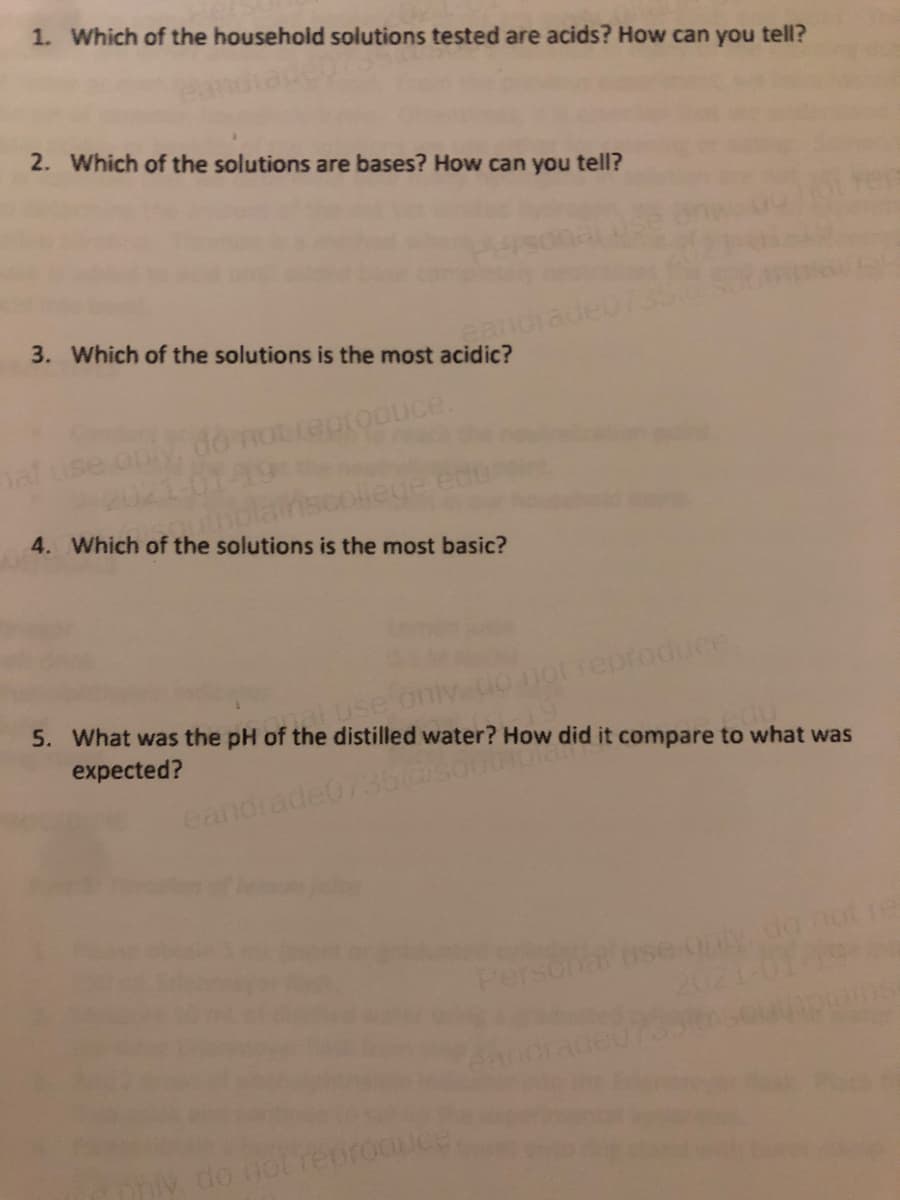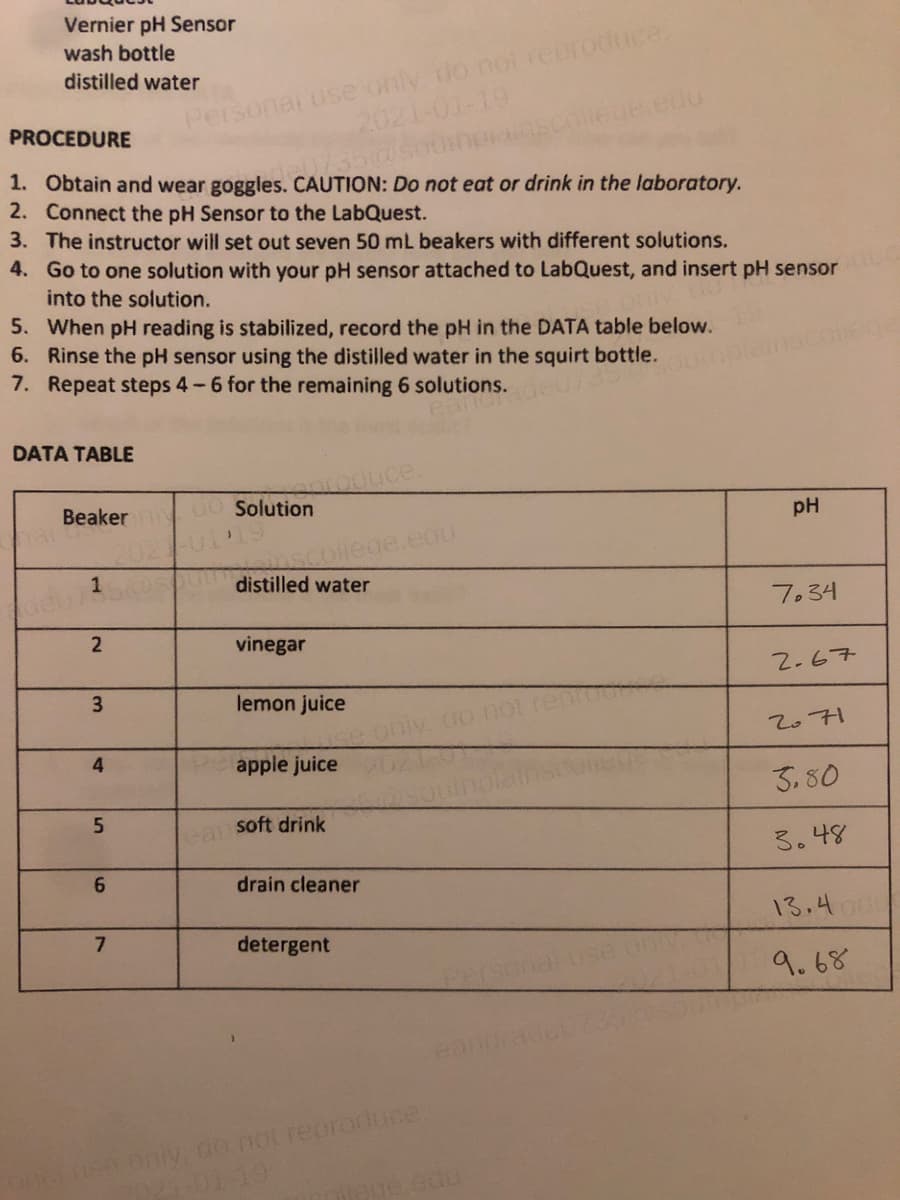1. Which of the household solutions tested are acids? How can you tell? 2. Which of the solutions are bases? How can you tell? 3. Which of the solutions is the most acidic? ean do not reproouce. 4. Which of the solutions is the most basic? Go not reproduce 5. What was the pH of the distilled water? How did it compare to what was expected? eandrade0736@s
1. Which of the household solutions tested are acids? How can you tell? 2. Which of the solutions are bases? How can you tell? 3. Which of the solutions is the most acidic? ean do not reproouce. 4. Which of the solutions is the most basic? Go not reproduce 5. What was the pH of the distilled water? How did it compare to what was expected? eandrade0736@s
Chemistry
10th Edition
ISBN:9781305957404
Author:Steven S. Zumdahl, Susan A. Zumdahl, Donald J. DeCoste
Publisher:Steven S. Zumdahl, Susan A. Zumdahl, Donald J. DeCoste
Chapter1: Chemical Foundations
Section: Chapter Questions
Problem 1RQ: Define and explain the differences between the following terms. a. law and theory b. theory and...
Related questions
Question
Needing help with the processing data

Transcribed Image Text:1. Which of the household solutions tested are acids? How can you tell?
2. Which of the solutions are bases? How can you tell?
3. Which of the solutions is the most acidic?
andi
al
4. Which of the solutions is the most basic?
aluse
notreproduce
5. What was the pH of the distilled water? How did it compare to what was
expected?
eandrade0735@sor
Pers
ai use ony do not re
do not renr

Transcribed Image Text:Vernier pH Sensor
Personal use only do not reoroduce.
2021-01-19
wash bottle
distilled water
PROCEDURE
735@sou
1. Obtain and wear goggles. CAUTION: Do not eat or drink in the laboratory.
2. Connect the pH Sensor to the LabQuest.
3. The instructor will set out seven 50 mL beakers with different solutions.
4. Go to one solution with your pH sensor attached to LabQuest, and insert pH sensor
into the solution.
5. When pH reading is stabilized, record the pH in the DATA table below.
6. Rinse the pH sensor using the distilled water in the squirt bottle.
7. Repeat steps 4-6 for the remaining 6 solutions.
DATA TABLE
roguce.
Beaker
00 Solution
pH
edu
nscolle
distilled water
7.34
vinegar
2-67
3.
lemon juice
271
4
apple juice
3.80
a soft drink
る。48
6.
drain cleaner
7
13.400
detergent
9.68
eand
sa oniy do not reproduce,
14:01-19
Expert Solution
This question has been solved!
Explore an expertly crafted, step-by-step solution for a thorough understanding of key concepts.
This is a popular solution!
Trending now
This is a popular solution!
Step by step
Solved in 3 steps with 3 images

Knowledge Booster
Learn more about
Need a deep-dive on the concept behind this application? Look no further. Learn more about this topic, chemistry and related others by exploring similar questions and additional content below.Recommended textbooks for you

Chemistry
Chemistry
ISBN:
9781305957404
Author:
Steven S. Zumdahl, Susan A. Zumdahl, Donald J. DeCoste
Publisher:
Cengage Learning

Chemistry
Chemistry
ISBN:
9781259911156
Author:
Raymond Chang Dr., Jason Overby Professor
Publisher:
McGraw-Hill Education

Principles of Instrumental Analysis
Chemistry
ISBN:
9781305577213
Author:
Douglas A. Skoog, F. James Holler, Stanley R. Crouch
Publisher:
Cengage Learning

Chemistry
Chemistry
ISBN:
9781305957404
Author:
Steven S. Zumdahl, Susan A. Zumdahl, Donald J. DeCoste
Publisher:
Cengage Learning

Chemistry
Chemistry
ISBN:
9781259911156
Author:
Raymond Chang Dr., Jason Overby Professor
Publisher:
McGraw-Hill Education

Principles of Instrumental Analysis
Chemistry
ISBN:
9781305577213
Author:
Douglas A. Skoog, F. James Holler, Stanley R. Crouch
Publisher:
Cengage Learning

Organic Chemistry
Chemistry
ISBN:
9780078021558
Author:
Janice Gorzynski Smith Dr.
Publisher:
McGraw-Hill Education

Chemistry: Principles and Reactions
Chemistry
ISBN:
9781305079373
Author:
William L. Masterton, Cecile N. Hurley
Publisher:
Cengage Learning

Elementary Principles of Chemical Processes, Bind…
Chemistry
ISBN:
9781118431221
Author:
Richard M. Felder, Ronald W. Rousseau, Lisa G. Bullard
Publisher:
WILEY